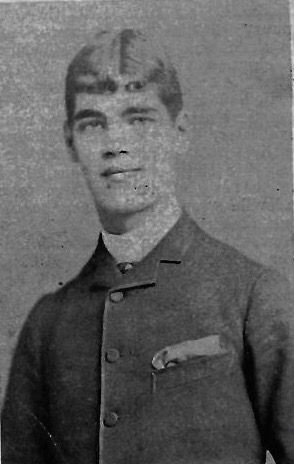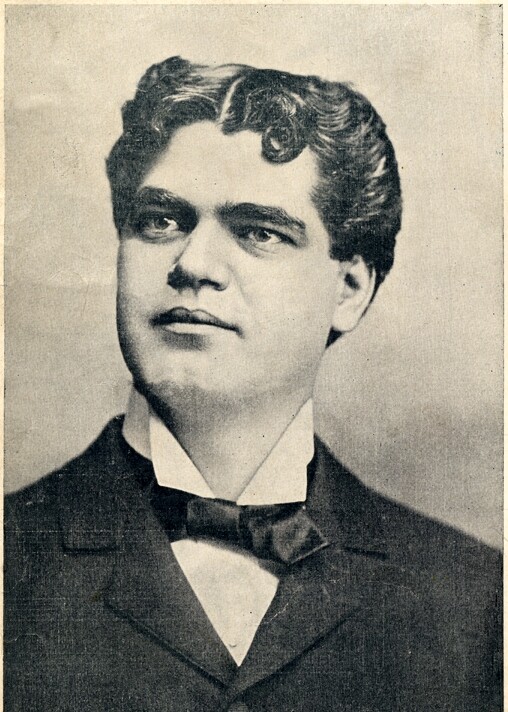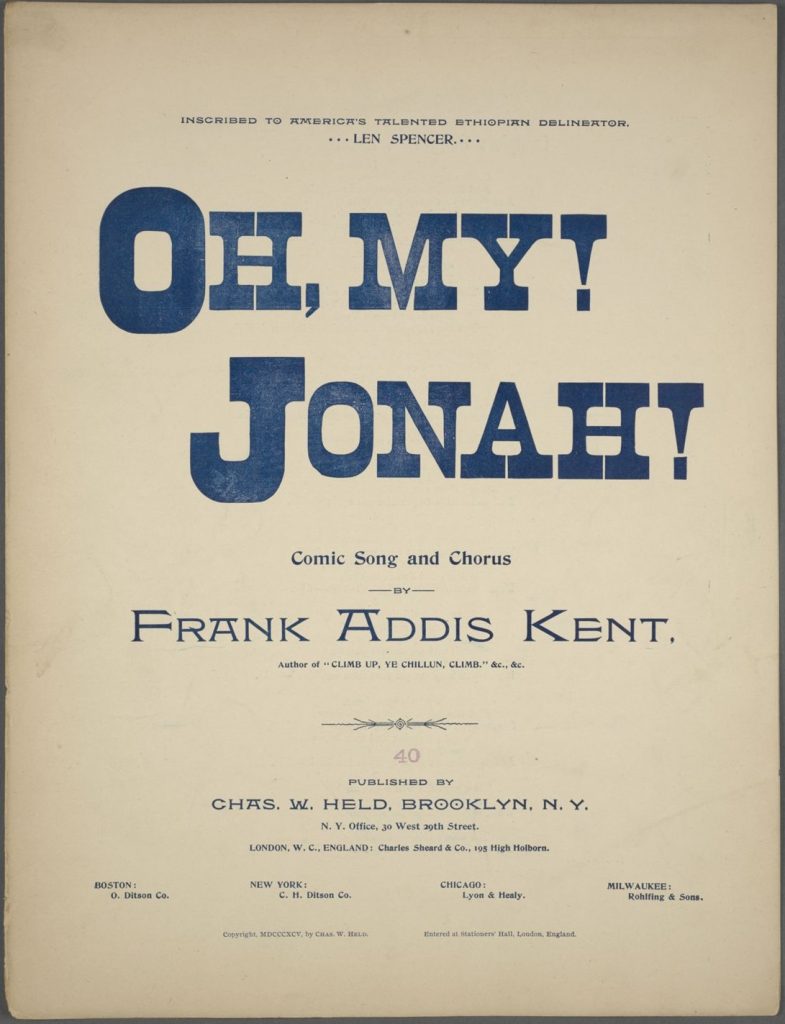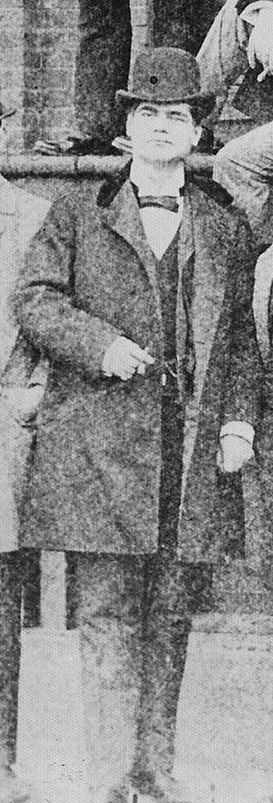
There were several recording stars in the 1890s and early 1900s who were known for performing ragtime songs, but one of the most famous of these was Len Spencer. His history as a ragtime singer is rather unusual, and actually includes some unexpected approval from black listeners of his recordings. While he wasn’t technically the best of these ragtime singers, his energy and style in the genre are notable.
Spencer started recording in 1888, and happened upon the phonograph very conveniently. At the time, his parents ran a successful business college in Washington DC (which is where the Columbia company was established), and his father had decided to invest in a few of these new machines for business purposes, such as dictation. Spencer became fascinated with the device and spent many hours experimenting with it (when he wasn’t working as a student teacher for his parents).
In 1889, when Columbia was officially established, he asked if he could make some records for them, and he did for 15 cents a round. According to accounts from Frank Dorian, one of the earliest employees of Columbia, he came in a few times a week, sat at the piano and sang into several machines to his own accompaniment for hours. This was very taxing work, but from it he was paid of course, but he also gained a reputation from the surrounding neighborhood.
According to Fred Gaisberg, Columbia’s first accompanist, Spencer had become very popular with the young black children of the area, as they were often convinced it was someone just like them making the records. The kids were surprised to see a very strange looking tall white man singing songs they all knew. The story goes that often the kids would come by the lab and ask for his autograph.
As sweet as this story is, the source from which it comes is a bit dubious at times. It is important to note however that Washington DC was home to several prosperous black neighborhoods. Gaisberg was a very important source for stories and history in the earliest days in the phonograph world, but his book The Music Goes Round, is known for including many stories that are blatantly inaccurate. This story is likely to be somewhat true however, as Gaiseberg would have been present for many of these recordings.

It was here at the very beginning of his career that Spencer was already being recognized for recording music popular with black listeners, which would soon be called ragtime. He was already recording syncopated songs, not just on his own but also as an assistant to recording’s first studio musician Edward Issler. Issler was a generation older than Spencer, but was often daring when it came to the material he recorded with his orchestra.
Most often when you hear an Issler’s Orchestra record, Spencer is the announcer and will often be playing some kind of percussion or doing shouts and calls. Some of the first recorded cake-walks were by Issler with Spencer’s calls. There are many examples, but one of these is “The African Wedding Dance,” first recorded around 1893. On this recording the announcement is done by Spencer, then he says thus: “…now that the wedding’s over, get your partners for the cake-walk!”
The piece itself becomes rather syncopated toward the end. While it is difficult to determine the date, the record was most likely made between 1893 and 1895. There is a seemingly endless amount of debate over when and where the first cake-walk was published, but by 1895 it was a commonly used term to describe a distinctly African American dance that usually involved some syncopation. It was scattered in published music, but was more commonly used in the regular vernacular of the time. By 1894, however, sheet music was already beginning to acknowledge Spencer’s talent for syncopated songs; there was a piece from 1894 called “Oh My Jonah!”That mentioned him at the top of the cover as: “America’s greatest Negro Delineator…”
Finding sheet music from before 1910 that mentions recording or recording artists is difficult enough, but this is definitely among the earliest to do so.
By 1896, this new type of music now was called ragtime. By the end of that year, record catalogs listing Spencer’s records were using the term to describe these songs he was then associated with. In December 1896, The Phonoscope noted a few recently released recordings for a very small company located at the top of Union Square, and one of these is specifically listed as “Oh Mister Johnson—A Rag Time Melody.” While Spencer was fully established as an expert on this new genre, there was still something lacking from his recordings, and that was accompaniments to match his energy and rhythm. It took until the end of 1897 for that very accompanist to appear, and this was Fred Hylands.
Hylands was what you might call an “outside hire,” or someone who came seemingly out of nowhere into the recording world. Most other folks employed at the major companies were living and working in areas where the studios existed. Take for example Issler and Frank P. Banta, both of whom were brought into recording early because they were from New Jersey, where Edison and U.S. were both established. Hylands was an outsider, from all the way out in Indiana. As soon as he was hired by Columbia he became famous for his ragtime accompaniments, and they were unique.

By the middle of 1898, Spencer and Hylands records were being specifically advertised for the very distinct ragtime they included. When looking over the titles that Spencer recorded between 1898 and 1901 for Columbia, it seems like an endless stream of ragtime. Some of these titles are recognizable, like “Hello Ma Baby” and “I’m Certainly Living a Ragtime Life,” but others are even unknown to the author, like “That’ll Be All Right Baby” (by Will Marion Cook) and “Blackballed in the Lime Kiln Club.”
Oftentimes, in catalogs and supplements, the section dedicated to these songs was more than everything else when it came to Spencer. He certainly had hit his stride when working with Hylands. You can easily hear the infectious energy of their recordings. Their recordings are not just some of the finest examples of recorded ragtime, but can occasionally be quite exhilarating to listen to, even nearly a century and a half later. Sometimes singers would acknowledge the accompanist by name on the recordings, but it is not known if Spencer ever did this. However is a take of Irving Jones’ “Get Your Money’s Worth” where Spencer changes the lyrics very slightly to include his favorite accompanist. In the sheet music, the lyrics read, “Do the high-land fling,” but Spencer says “Hylands fling.” It’s a very slight change, but it is quite notable.
After 1901, things at Columbia changed dramatically. The first thing that really brought this change was the beginning of their new disc division, marketed as Climax. At this time Columbia hired a new music director, Fred Hager. Hager, like Hylands and Spencer, was very up to date on the latest ragtime, and sometimes might have even gone a step further, considering that he was younger than both of them. While this might seem like a good thing on the surface, Hager was not very flexible when it came to his management in the studio, and it was at this time that many of the most popular brown wax era performers were beginning to retire from the studio. The technology was changing, and many new faces entered in the business, replacing the old ones.
While Spencer didn’t go anywhere, he had significantly diminished the amount of singing he did after 1902, and it was at the end of that year when Hylands left recording for good. By the middle 1900s the only singing he did was for a quarter of his many dozens of characteristic sketches with Ada Jones.
So do yourself a favor, go listen to some of those Spencer and Hylands Columbias, they are truly unique and enjoyable to any fans of ragtime, even today.
R. S. Baker has appeared at several Ragtime festivals as a pianist and lecturer. Her particular interest lies in the brown wax cylinder era of the recording industry, and in the study of the earliest studio pianists, such as Fred Hylands, Frank P. Banta, and Frederick W. Hager.






















